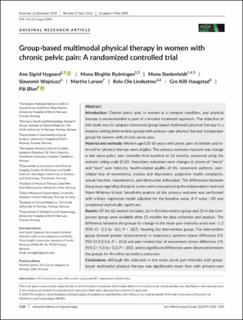| dc.description.abstract | Introduction - Chronic pelvic pain in women is a complex condition, and physical therapy is recommended as part of a broader treatment approach. The objective of this study was to compare structured group‐based multimodal physical therapy in a hospital setting (intervention group) with primary‐care physical therapy (comparator group) for women with chronic pelvic pain.
Material and methods - Women aged 20‐65 years with pelvic pain ≥6 months and referred for physical therapy were eligible. The primary outcome measure was change in the mean pelvic pain intensity from baseline to 12 months, measured using the numeric rating scale (0‐10). Secondary outcomes were changes in scores of “worst” and “least” pain intensity, health‐related quality of life, movement patterns, pain‐related fear of movements, anxiety and depression, subjective health complaints, sexual function, incontinence, and obstructed defecation. The differences between the groups regarding change in scores were analyzed using the independent t test and Mann‐Whitney U test. Sensitivity analysis of the primary outcome was performed with a linear regression model adjusted for the baseline value. A P value <.05 was considered statistically significant.
Results - Of the 62 women included, 26 in the intervention group and 25 in the comparator group were available after 12 months for data collection and analysis. The difference between the groups for change in the mean pain intensity score was −1.2 (95% CI −2.3 to −0.2; P = .027), favoring the intervention group. The intervention group showed greater improvements in respiratory patterns (mean difference 0.9; 95% CI 0.2‐1.6; P = .015) and pain‐related fear of movements (mean difference 2.9; 95% CI −5.5 to −0.3; P = .032), and no significant differences were observed between the groups for the other secondary outcomes.
Conclusions - Although the reduction in the mean pelvic pain intensity with group‐based multimodal physical therapy was significantly more than with primary‐care physical therapy, the difference in the change between the groups was less than expected and the clinical relevance is uncertain. | en_US |

